#vermivora cyanoptera
Explore tagged Tumblr posts
Text

Setophaga americana | Vermivora cyanoptera | Mniotilta varia | Vermivora chrysoptera | Helmitheros vermivorum
Plate XI | Die Nordamerikanische Vogelwelt (1891)
#bird art#bird illustration#vintage art#vintage illustration#artists on tumblr#parulidae#new world warblers#setophaga americana#northern parula#vermivora cyanoptera#blue winged warbler#mniotilta varia#black and white warbler#vermivora chrysoptera#golden winged warbler#helmitheros vermivorum#worm eating warbler#gustav mützel
18 notes
·
View notes
Text

Blue-winged Warbler (Vermivora cyanoptera), family Parulidae, order Passeriformes, eastern U.S.
photograph by Matthew Studebaker
#warbler#wood warbler#vermivora#parulidae#passeriformes#bird#ornithology#animals#nature#north america
335 notes
·
View notes
Photo

Brewster's Warbler (hybrid) (Vermivora chrysoptera x cyanoptera (F1 hybrid))
© Matt Felperin
91 notes
·
View notes
Text
The State Birds Initiative: Connecticut (#5)
Hoo boy, it's been a minute! But hey, here we are again, after taking some extra time to figure stuff out. Welcome to the fifth official poll of the State Birds Initiative! Before the poll, though, one thing real quick. My suggestion is that you read the post below before voting in the poll below. That's especially important if you're lacking any context about the birds being presented as the new (or old) State Bird of the Nutmeg State, Connecticut. This is to be fully informed as to why these are being presented, and to make your choices appropriately. Lastly, some of these birds, you will notice, may go against some of the rules listed in the introduction post. All is explained after the jump where the explanations are, I promise you that. And apologies in advance, the spiel before the actual bird selection is...long. But with that...OK! Here's the poll!

Welcome to the Nutmeg State! A small state, mostly known for being between Boston and New York City, this is one of the foundational states of southern New England, while also having a somewhat...divided identity, we'll say. So, I grew up in CT, for part of my childhood, in both the classic upscale suburbs, and in the middle of the goddamn woods, right on the Connecticut River. For the record, the name "Nutmeg State" is based off of salesmen from the state known for peddling nutmegs. However, there's some speculation that the nutmegs sold were actually made of wood, but that's also probably from people who didn't know that nutmegs were supposed to be grated, and instead assumed they had to be cracked like walnuts. They tried, that failed, and they accused Connecticut Yankees for selling fake nutmeg as a result. So, yeah, a confusing legend at the root of the state's nickname.
You'll notice my use of the word "Yankee" there. Well, despite New York's domination of the term, it should arguably be most associated with Connecticut. "Yankee Doodle" is literally the state song; people from CT were previously and historically referred to as Yankees (which was also an epithet applied to northerners in general, to be fair); and it's actually possible the word was first used by the Dutch in reference to Connecticut settlers, according to multiple theories and historical references. But maybe most prominently, Yankee was used as a demonym for people from CT by one of its most favorite residents: Samuel Clemens, AKA Mark Twain.

Twain is, of course, Connecticut's most famous author, having written some of his most famous works while living with his family in Connecticut in his West Hartford house (which every central Connecticut middle school kid has been to at least once, I guaran-goddamn-tee it). Fun fact, though! Did you know...uh...ah, fuck it. Why keep stalling at this point? Look, as much as I love talking about Mark Twain, he was nothing to do with this post. Fact of the matter is...this was a hard one.
Look, I love Connecticut. It was the first state I remember living in, having moved there when I was a kid from the United States Virgin Islands, which I had been really looking forward to for a bunch of reasons. Admittedly (and unsurprisingly), a lot of that was because I was looking forward to seeing the birds! As a kid, I was also obsessed with birds, and I had never seen the birds in the US mainland before. It was an exciting time for me, and I honestly enjoyed growing up in CT, for the most part. I'd be there for almost 6 years of my life, and I have a lot of fond memories of the state. But, uh...ironically enough...finding State Bird nominees for Connecticut has been HARD AS HELL.

We will, of course, talk in GREAT detail about the American Robin (Turdus migratorius), as it's an important bird for more states than just Connecticut, but I'll give you a spoiler now: this is a boring choice for a State Bird. For any state. Don't get me wrong, I love robins! They're an extremely charismatic and iconic bird, and everybody has seen them at least once in their life if they live in the USA. They're also most likely an early bird (pun slightly intended) for people to encounter on a personal standpoint. Again, we'll get to them, but they're a notable entry in this list. And if one of the states kept the American Robin, I would understand. But, uh...is that state Connecticut?
OK, let's look at the state in the same vein as we have others. I'm sure this won't be the last difficult state to examine in the future of this project, so why not do the same here? Starting with habitat, Connecticut is another state placed within the Northeastern Coastal Zone, with a ton of deciduous forests dominated by oak, chestnut, hemlock, and white pine. There was a lot of clearance during early settlement and beyond, but succession has taken over in recent years to grow the forests back. The state's cut in half by the Connecticut Valley, with large floodplains dominated by maple and cottonwood, with the large Connecticut River right in the center of the valley. Finally, the Berkshires in the northwest corner of the state give us some classic New England flair with sugar maple (Acer saccharum), ash, beech, birch, oak, and hemlock trees on higher-altitude slopes, creating a hilly area that turns beautiful colors in fall. Man, I love Connecticut autumns. And the rest of the year, for that matter.

OK, what are Nutmeggers most known for, culturally and historically? It's a diverse state with a lot of mixed culture, partially as a result of its proximity to New York City. A lot of people tend to joke that Connecticut is just New York City, especially people from elsewhere in New England. And having been to NYC a lot when I was a kid, with a mom who worked there part of the week, and an aunt who lived there all of the week...yeah, fair. But Connecticut has a much more detailed culture than that. It's the home of the cotton giiiAAAAAAH, bad place to start that list. Uh, let's see, it's the home of whaliiiiiiing. Jesus. Uh...home of Mark Twain and Harriet Beecher Stowe? OK, that's better. It's a major seat of the Industrial Revolution in the United States, leading to it being a production hub for textiles, clocks, typewriters, machining, sewing machines, steam engines, aircraft, and honestly, women's rights to a certain degree. After all, it's the home of the Radium...Girls. Huh. OK, CT's history has some bumps in it, but what state's history doesn't?
As for modern Nutmeggers, they're industrious, generally well-educated, and honestly quite a bit eccentric. I've gone back to the state a few times in the last couple of years, and I forgot how honestly weird people are there. In a good way, not in the fucked-up MAGA sense of the word. It's a state whose people are unafraid to express themselves, from my experience. Probably a result of the diversity in the state, and the diverse perspectives that result. Its political atmosphere is a bit complicated, but overall pretty liberal. Which...doesn't translate super-well into birds at first blush, but hey, we'll see what we get!

OK, with that, let's jump into the selection of the birds for this list. Real talk, if anybody has a suggestion that I hadn't brought up here, send it my way! I will absolutely add another poll if there are entries I think could bear fruit. But, in the meantime, read on if you're interested in the possible choices for the State Bird of Connecticut!

American Robin (Turdus migratorius)
I think you'd be hard-pressed to find an citizen of the United States of America who hasn't seen a robin. This is, by far, one of our most iconic songbirds, and is certainly one of the most common and widespread. For some of us, they're a sign of spring. For others, they used to be a sign of spring, until global warming prompted some individuals to stick around through the winter, shifting their diet to frugivory a bit more and brightening the snow as well. They're prolific breeders with bright blue-green eggs (which are iconic in their own right), and can have up to three broods in a given season! Extremely successful and very common. And that...is a problem, for our purposes.
See, Connecticut, Michigan, and Wisconsin have the American Robin (Turdus migratorius) for their state bird, and none of them actually have a good reason for that choice. In Wisconsin, it was chosen by schoolkids because it was recognizable. That was also the reason for the Michigan Audubon Society to choose it as state bird. And Connecticut? Absolutely no goddamn idea. It's almost certainly for the same reason, but there is no real recorded reason for the choice of the American Robin as a state bird, as far as I can tell. For literally all of those states, it's a pretty bad choice by virtue of not being a good choice, at the very least. But that said...I mean, it's not the worst possible choice for a State Bird. For one state, anyway.

Robins, for the record, were named after a different robin entirely: the European Robin (Erithacus rubecula). Another red-breasted and beloved songbird, the European Robin was an immediate thought when American settlers saw the American Robin, hence why I keep saying "American". The two are so often confused in pop-culture, even Mary Poppins was guilty of it! That GIF above comes from the film, and in case you haven't realized it yet, that's an American Robin in England. Yeah. Wrong bird to use as a model for your animatronic, Disney. That has bothered me since I was a little kid, I swear to GOD. Erroneous film biogeography is one of my biggest pet peeves...but that's a separate conversation.
Back to the American Robin. Personally, I love robins of all species, and even recently did some genomics work with them (DNA extraction is fun). They're a commonly seen species, and a great entry-level bird for kids to get into birdwatching and nature. As an American icon, I genuinely think these guys should get some recognition...but I'm hard-pressed to say Connecticut needs them as a State Bird. We'll see what people think, but there's not a great case for them to get the title. To keep it...like I said, we'll see. Maybe the others won't be deemed as good a fit for the state. For now, let's move on from a popular backyard bird to a MUCH less popular one.

Blue-winged Warbler (Vermivora cyanoptera)
Here's the eBird pick for Connecticut, and for good reason! The vast majority of the Blue-winged Warbler's (Vermivora cyanoptera) breeding population is in...Wisconsin. Wait, what? Hold on...yeah, actually, Wisconsin, New York, Missouri, Ohio, Pennsylvania, and West Virginia all have higher shares of the population that Connecticut, with 5% overall. That's still a lot better than the American Robin's share in CT (0.2%), but still...seems like that eBird article is SEVERELY outdated, or I'm using the database wrong somehow. Either way...huh. Well, let's make an argument for the Blue-winged Warbler, anyway.
Blue-winged Warblers are a species of some conservation concern, making them automatically of interest. They're also extremely interesting to geneticists and ornithologists because of their relationship to other members of Vermivora, especially the Golden-wined Warbler (Vermivora chrysoptera) and extinct Bachman's Warbler (Vermivora bachmanii), with having documented hybrid offspring with the former that's of interest for various reasons. But outside of that, they of course breed in Connecticut, and represent an interesting bird to look for and find, with a recognizable song and appearance. It's also prized by birdwatchers, and would be a good bird for any aspiring or experienced birdwatchers. It also inhabits shrubland, which is of some conservation interest to CT government and environmental officials. But other than that...not too much else.

Connecticut Warbler (Oporornis agilis)
No. Look, I'm just gonna say this now: no. The Connecticut Warbler (Oporornis agilis) not only doesn't breed in the state (and possibly has never bred in the state), but it's pretty much not found there. Like, at all. This is not an easy warbler to get anywhere in its range in the US, but Connecticut isn't included in that distribution. "But lonelywretch," you scream at your computer screen, "why is it called the Connecticut goddamn Warbler if it isn't even from the state?" First of all, not to police your emotions, but stop screaming; way overboard for this situation. Second of all, it's called the Connecticut Warbler because its describer, ornithologist Alexander Wilson, first saw it in a fly-by during migration while in Connecticut. And...yeah, that's it. They do fly through the state very occasionally during migration, but it's definitely not a reliable bird to count on for local birders there. Honestly...bad bird for the state.
Side note here: there's a lot of talk about renaming birds that are named after people, and I agree with that in almost every case. But here's a hot take to elaborate on in another series: location-based names need to be re-examined. Not all of them are bad by any means, but the Connecticut Warbler is a great example of a bird whose name makes NO FUCKING SENSE. Rename this bird, I BEG of you. If anybody has suggestions for a renaming of this bird, throw them in notes for something! Keep in mind, Gray-headed Warbler is taken (by Myiothlypis griseiceps), so come up with somethin' else. Warranted inclusion in the list for its name, but we're gonna move on.

Osprey (Pandion halieetus)
It's at this point in the list where we get into some interesting candidates...and where I had the most trouble. But I'm fairly satisfied with what I've come up with, so let's move forward! This entry's a somewhat controversial pick for a few reasons, but an interesting one for a bunch of reasons. Now, I don't know about you, but I love Osprey (Pandion halieetus) a whole bunch. An iconic raptor, as well as a very unique one, they're a pescivorous bird found throughout the entire continent. And in Europe. And Asia. And Africa, Australia, and South America. Yeah, they're a cosmopolitan species, found in every continent except for Antarctica. That automatically should make them a bit dodgy of a choice for a State Bird, since they can be found in every state (yes, even occasionally Hawaii). So, why Connecticut?
First off, Connecticut has an intimate connection with the shore and rivers, especially the Connecticut River. Seemingly a loose reason, but the Osprey, AKA the river hawk or sea hawk (we'll get to that later) is an iconic riparian raptor, and a common sight in Connecticut. Having grown up on a river in the state, we used to see Osprey all the time, and it was awesome every time. But their commonness in the state is an important story in and of itself. And, if you know anything about Osprey at all, you know where this is headed. And Connecticut is a great example of this story.

The Osprey is one of the most iconic victims of the DDT crisis that hit the country, as well as a symbol of the environmental success story that resulted from its banning. I won't go into the full story if you haven't heard it, but the short of it is that the pesticide DDT was inadvertently ingested by fish-eating raptors, especially the Bald Eagle (Halieetus leucocephalus) and the Osprey, causing the eggs they laid to have weakened, soft shells. This caused a massive decrease in these and other species, nearly driving both into extinction. However, once environmental movements prompted by Rachel Carson and her book Silent Spring advocated for its eventual banning, the populations recovered. And in Connecticut, they've recovered A LOT.
In 1940, somewhere near 1,000 nests were recorded for Osprey between New York City and Boston. By 1970, the number in Connecticut was down...to 8. Jesus Christ, that's a hell of a crash! One of the worst in the country, in fact. However, today in Connecticut, there are 688 active nests in the state. Which, yeah, doesn't seem like the ultimate success compared to previous, but what's interesting is the rate of increase. Because in 2014, according to the Connecticut State Audubon, there were only 210. In ten years, the number of breeding ospreys known was more than tripled. That's incredible. This has quickly made the Osprey a symbol of conservation in the state, because of a massive amount of monitoring increase. There are states with more of a population, but Connecticut has a pretty good argument for having the Osprey. But that said...other states could also claim this species. Florida and Maryland definitely have claims on it for population size alone, not to mention, well...the most iconic state of all when it comes to having ospreys as a symbol. But we'll get to that one WAY later. just keep that in mind before you vote for Connecticut to have the Osprey.

Sharp-shinned Hawk (Accipiter striatus)
The Sharp-shinned Hawk (Accipiter striatus OR Astur striatus as of recent taxonomic proposals), on the other hand, is another bird of interest. The smallest hawk in the United States of America, this already seems a fitting choice for one of the smallest states in the country. It's listed as endangered in the state, immediately making it of interesting conservation focus. The reason for this status is likely because of window-strikes, which are common for the species in Connecticut, meaning that there's some public outreach needed to protect it. Protecting the forests they nest in (which are in danger) is one thing, but putting up protective window decals to help the species is another. Definitely a cause for focus.
However, there is one...minor detail that makes this a harder fight for public opinion, as well as a potentially ironic one. This is the first species we've discussed whose diet is basically exclusively birds. If you're in the Northeastern United States, and you've seen a bird get attacked and taken at your birdfeeders, it's almost certainly this guy. Which is cool, and important for the species' survival, but the average person being asked to protect a bird that kills other birds, especially birds like the American Robin, is...a palpable irony. Granted, it genuinely needs protecting, and has monitoring programs in the state, and it is a genuinely interesting raptor! But, this is a slightly harder fight to win because of that noncharismatic factor. But hey, it's a cool bird in genuine trouble in the state, it's a scrappy bird for a small state, and it's an interesting species to highlight!

American Black Duck (Anas rubripes)
This is another difficult bird to fight for, but one that needs attention, for God's sake. The American Black Duck (Anas rubripes) is a rapidly disappearing duck species, and not for the reason you think. Let's get to Connecticut representation first. It was the first bird to be used for the Connecticut Migratory Duck Stamp in 1993, the first one issued for the state. It's one of the few states in which it breeds (although it's not the primary state of focus, detracting from its candidacy). And, it's a controlled bird by Fish and Game, meaning hunting of the Black Duck is extremely limited. There is, surprisingly, a point to that statement, but I won't be elaborating here. We'll see how the vote goes, and I'll address it in the Results post.
So, why is this a potential issue? Well, Maine and New York arguably should get this bird instead, as they have a higher population. And the breeding population of this bird is incredibly important to promote, because it's disappearing. Why is it disappearing? Well, some of you may have looked at that picture and asked yourselves: "Wait...isn't that just a female Mallard?" And the answer is, no! But a lot of people think that. A lot of birds think that. Mallards think that. Which means that hybrids between Mallards and Black Ducks are incredibly high. SO high, in fact, the species is being bred and hybridized out of existence! They're so similar to Mallards on a genetic level at this point, that they'll be subsumed if their individual populations aren't preserved. So, yeah, these guys deserve some focus. Do I think they're a great Connecticut symbol? Well, to be fair, the state is regularly assumed to be either greater New York City or greater Massachusetts by outsiders. And it's not; it has its own identity that deserves to be preserved for what it is. So, yeah, maybe a good fit for Connecticut after all.
Also, it's the state in New England with the highest proportion of Black Americans (yes, even more than Massachusetts), so...I dunno, that's also something? Probably not, but as a black dude that grew up in CT, I felt the need to bring that up.

Snowy Egret (Egretta thula)
OK, sing it with me now!
Yankee Doodle went to town, a-riding on a pony; Stuck a feather in his hat, and called it "macaroni"! Yankee Doodle, give it up! Yankee Doodle Dandy, Mind the music and the step, and with the girls be handy!
Ooh, that last line aged a little rough, but Yankee Doodle! The Connecticut state anthem! Yes, really. Most Americans in the Northeast know this song, but it's got a unique resonance for Nutmeggers, seeing as it was allegedly based on the son of a Connecticut mayor! The state chose it as their song in 1978, and it's been a beloved symbol ever since. But, for the uninitiated (and probably to most school kids like I was), there is one weird word in there that needs a little explanation: macaroni.

Now, this does not, of course, reference the easy cheesy favorite of every child (and college student). No, this is a reference to an old 18th century term for a form of fashion back in the day. It's what the 2000s called "extra", or bourgeious (pronounced "bougie", of course). Basically, it's somebody who dressed WAY over the top in high-designed clothes and accessories to the point of looking...well, extra. Another applicable 2000s term would be "metrosexual", I guess. The macaroni became a satirical character in British culture, and would later become another character known as the "dandy". It's sort of a class-related satire, to be honest. In any case, the macaroni was known for over-the-top fashion, including...wigs.
So, what does literally any of this have to do with the Snowy Egret (Egretta thula)? More than you'd expect, actually. First off, the egret has a pompodour-like crest of feathers that makes it look quite like a stereotypical macaroni, in my opinion. Secondly, it does breed in Connecticut, albeit extremely rarely, sparely, and barely. Its population in the state used to be a lot greater...until people came around and starting hunting it down. Why, you ask?

Let's just go ahead and call that macaroni now, while we're at it. To be clear here, quite a lot of birds were used in millinery back in the day, but the Snowy Egret (and the Great Egret (Ardea alba), for that matter) are special. Those long white feathery plumes were heavily prized as hat decorations, enough so that the species nearly went extinct from hunting them for the hat trade. As a result of that, people began to turn their eye towards conservation of the species, and the protection of birds in general. Two women, Harriet Hemenway and Minna B. Hall, got a group of women together to protect the birds. They rallied the troops, and their organization became fairly popular. Eventually when they sought to name it, they did so after one of the most famous ornithologists in American history at the time: John James Audubon. And from there...well, you can guess.
The Audubon Society is one of the premiere bird conservation organizations in the world, and especially in the United States, and is well-known to the public sector. And it was born right here in...Massachusetts. Oh. Wait, have I jumped the gun on this one? Maybe a little, yeah. But, in my defense, the macaroni is linked to Connecticut through its state anthem, and the Snowy Egret is linked to the macaroni, as mentioned. But, OK, maybe this is a better proposal for Massachusetts, not Connecticut. But, uh...there may be another contender. Kind of.

Tufted Titmouse (Baeolophus bicolor)
OK, here me out on this one. Look at this picture of a classic macaroni character (on the right, for the record). Does that hairdo not kinda look like the crest of the Tufted Titmouse (Baeolophus bicolor)? Like, just a little bit, at least? I dunno, I can definitely see it. But OK, outside of that, is there another reason for the Tufted Titmouse to be the State Bird of Connecticut? Well, they're extremely common, they've got some charisma to them, and they're definitely found breeding in Connecticut. But...I don't know. I think they're plenty charismatic, but I'm not sure that makes them a great contender.
Still...they should be represented somewhere, right? I mean, the species breeds entirely in the USA, even though it can be found in Canada as well. Plus, other than being very recognizable, they're also an easy bird to find and support with backyard birdfeeding. And, if you want a fun fact about them, they're prone to kleptotrichy. That means, they pluck the fur from mammals to use as insulation in their nests! Yeah! They actually pick the winter coat off of dogs, and use it for their nests! Adorable. But yeah, does this really count for a good State Bird of Connecticut? I doubt it, but I'll let you vote! And I swear to God, it better not be just because of the name that it gets votes.

There you have it. Some complex and controversial choices. I miss any that you think are a valid choice for the state? Do let me know, and I may just issue another poll if this one isn't good enough. We shall see. But, for now, I think it's time to move onto the next state. And lemme tell you, I'm real excited about that one, since...well, I live there! And I have some ideas, lemme tell you. And some people will...disagree with me. For sure. Anyway, see you next time in Boston, kid!

See you soon, and happy birding!
Introduction to the State Birds Initiative
1. Delaware - Poll | Results 2. Pennsylvania - Poll | Results 3. New Jersey - Poll | Results 4. Georgia - Poll | Results 5. Connecticut - Poll | Results 6. Massachusetts - Poll | Results
#bird#birds#birding#birder#birders#birdwatching#bird watching#black birder#state bird#state bird initiative#state birds initiative#birblr#birdblr#american robin#turdus migratorius#blue-winged warbler#warbler#connecticut warbler#osprey#long post#tufted titmouse#snowy egret#american black duck#black duck#birds of tumblr#poll#tumblr poll#blazed posts
59 notes
·
View notes
Text
Warbler Showdown; Bracket 8, Poll 1

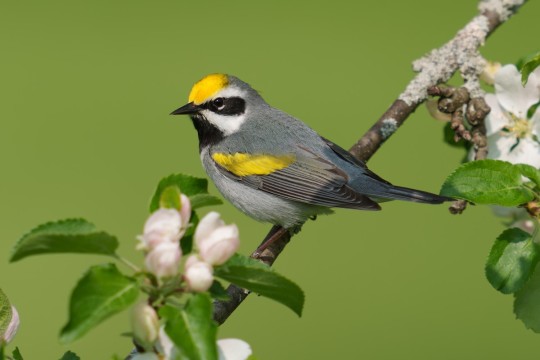
Blue-winged Warbler (Vermivora cyanoptera)
IUCN Rating: Least Concern
Range: migratory; Eastern US makes up most of the breeding range, with heavy concentrations in Appalachia, Wisconsin, and Missouri; overwinters in southern Mexico and Central America, down to Costa Rica.
Habitat: breeds in early to mid-successional habitat, with patches of dense, herbaceous growth and some tree cover. Their range has expanded thanks to abandoned farmland and clear-cut forests becoming more popular in northern states. Overwinters in humid or semihumid evergreen and semideciduous forests and their edges, but is otherwise poorly understood in habitat choice.
Subspecies: none
Golden-winged Warbler (Vermivora chrysoptera)
IUCN Rating: Near Threatened
Range: migratory; breeding range now heavily restricted to northern Minnesota, Wisconsin, and Michigan, with other populations occurring in southern Ontario and northern New York. Overwinters in Central America, from very Southern Mexico to the northern edge of Colombia.
Habitat: prefers clear cuts with very little canopy cover but high herbaceous cover, also seeming to prefer wetter habitats than the Blue-winged Warbler. Overwinters in similar habitat, though they're more likely to use forested areas.
Subspecies: none
Image Sources: Blue (Luke Seitz) Golden (Austin Groff)
#NWW Showdown#blue winged warbler#golden winged warbler#vermivora#parulidae#passeriformes#polls#bird poll#animal poll
10 notes
·
View notes
Text
i identified the birds for anyone who is curious :)
Cyanocitta cristata, Southeastern Blue Jay
Icterus galbula, Baltimore Oriole
Tachycineta bicolor, Tree Swallow
Setophaga ruticilla, American Redstart (almost confused this for the I. galbula again)
Icterus spurius, Orchard Oriole
Archilochus colubris, Ruby-Throated Hummingbird
Mniotilta varia, Black-and-White Warbler
Vermivora cyanoptera, Blue-Winged Warbler (i think)
Pheucticus ludovicianus, Rose-Breasted Grosbeak
Passerina cyanea, Indigo Bunting
Setophaga petechia, Yellow Warbler
Bombycilla cedrorum, Cedar Waxwing
Cardinalis cardinalis, Northern Cardinal
Cute birds appreciation post
85K notes
·
View notes
Photo

Blue-winged Warbler (Vermivora cyanoptera) 💙 05/10/2023 - 05/13/2023 NY & VT US #bluewingedwarbler #warbler #bestbackroad #bestbackroads #natgeoyourshots #natgeo100contest #natgeo #rutlandcountyvt #washingtoncountyny #whitehallny #wildphotography #naturephotography #adventurephotography #wildlifephotography — view on Instagram https://ift.tt/8THAPVe
0 notes
Photo
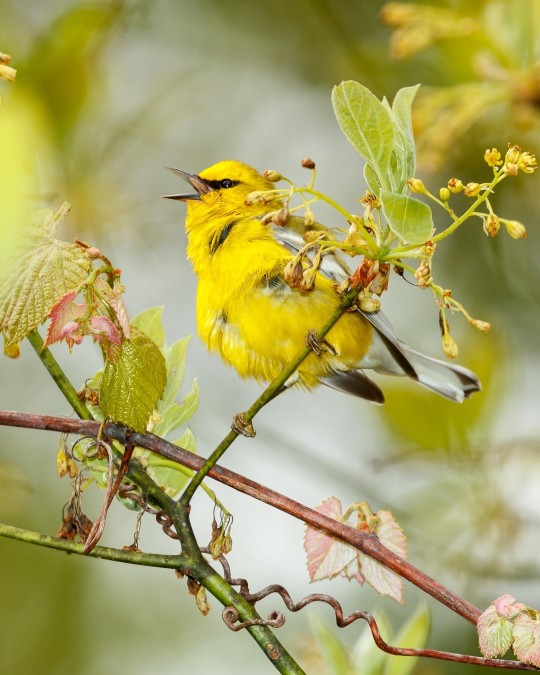
Blue-winged Warbler
18 notes
·
View notes
Photo

May 20, 2017 - Blue-winged Warbler (Vermivora cyanoptera)
Breeding in the northeastern United States, these warblers migrate through the southeastern US and eastern Mexico to the Caribbean and eastern Central America. They eat insects and spiders, foraging in trees and shrubs, often while hanging upside down. Females build open cup-shaped nests from grasses, bark, and dry leaves, on or near the ground and do most of the incubation, while males occasionally bring them food. Males bring most of the food for the first few days of the chicks’ lives, then both parents feed them. They often interbreed with the Golden-winged Warbler, resulting in two intermediate-plumaged hybrids, known as Brewster’s Warbler and Lawrence’s Warbler.
54 notes
·
View notes
Photo

Decembird Day 26: Fantasy
The ever-warring Warbler Clans did everything they could to differentiate themselves. They sang different spells, traveled different paths in the skies, weaved their cloths differently, and wore their family crests with pride, vowing never to mix. Nevertheless, Twi-zi-zi of the Gold Wings carried on with his courtship of the young maiden Fii-zu of the Blue Wings...
This is heavily inspired by the fantasy birds and writings of @virginiagreene, especially the armor designs!
#decembird2016#birblr art#warbler#artbysnailkites#fantasy#blue winged warbler#golden winged warbler#vermivora#Vermivora cyanoptera#vermivora chrysoptera#parulidae#passeriformes
153 notes
·
View notes
Photo
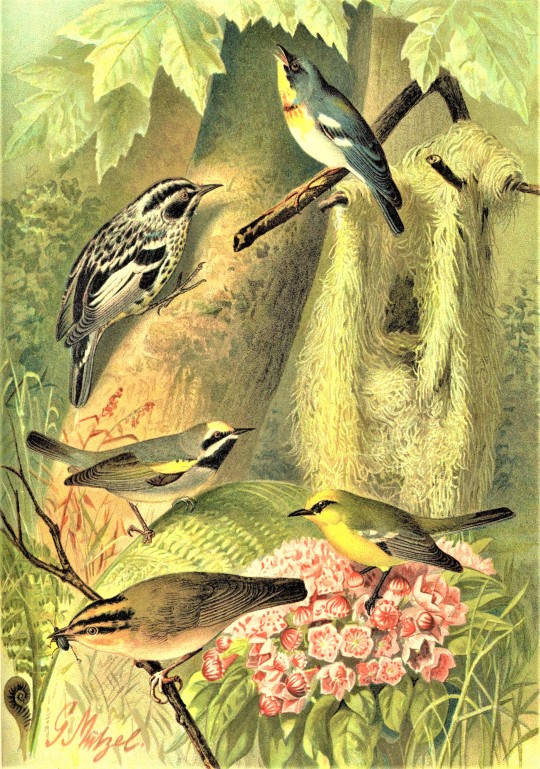



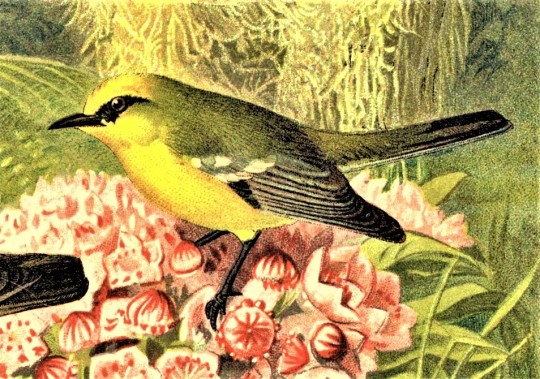
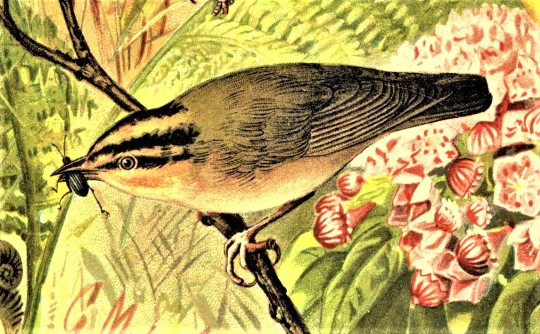
A Warbling Feathursday
While we enjoy watching and identifying birds, the many species of warblers just confuse everyone in our department. They’re tiny and fast, there are way too many species, and learning their individual calls is just too much. Very unfortunately, the only time we get a really good view of a warbler is after they have hit one of the windows here on campus. But even with a field guide, it’s still a chore to land the right identification. Still, they are beautiful little creatures with exquisite warbling songs.
Shown here are chromolithographs of five North American warblers, from a painting by the noted German wildlife artist Gustav Mützel, found in our 2-volume set of Our Native Birds of Song and Beauty, by the late-19th-century director of the Milwaukee Public Museum Henry Nehrling, and published in Milwaukee by George Brumder from 1893-1896. They are from top to bottom:
1.) Northern Parula (Setophaga americana) 2.) Black-and-white Warbler (Mniotilta varia) 3.) Golden-winged Warbler (Vermivora chrysoptera) 4.) Blue-winged Warbler (Vermivora cyanoptera) 5.) Worm-eating Warbler (Helmitheros vermivorum)
Of these, only the Golden-winged and Blue-winged inhabit our area, and we have indeed found them on the pavement next to campus buildings, sad to say. Hard to think about, but at least this lovely chromolith lifts our spirits.
View more posts from Nehrling’s Our Native Birds.
View more Feathursday posts.
#Feathursday#warblers#Northern Parula#Black-and-white Warbler#Golden-winged Warbler#Blue-winged Warbler#Worm-eating Warbler#Gustav Mützel#Henry Nehrling#George Brumder#Our Native Birds of Song and Beauty#chromolithographs#Yay chromoliths!#birds#birbs!
48 notes
·
View notes
Photo
Vermivora cyanoptera - Familia Parulidae


Blue-winged Warbler, Eric S. Liner / Cornell Lab
386 notes
·
View notes
Note
Hello! I love your page so much ❤️. I'm beyond interested in hybrids like this. Do you have any pictures of other bird hybrids? I only know of a few. 🙂↕️

Hybrids!
Well, this is a new one for me. I hadn't heard of this hybrid before!
The hybrids that always come to mind for me with North American birds are the Golden-winged Warbler and Blue-winged Warbler hybrids.

New research from the Cornell Lab of Ornithology’s Fuller Evolutionary Biology Program shows that the genetic differences between Golden-winged and Blue-winged Warblers are found in just six regions (or .03 percent) of their entire genomes. One of those regions contains genes that control throat coloration. Illustrations by Liz Clayton Fuller, Bartels Science Illustration Intern.
Read more: Golden-winged and Blue-winged Warblers Are 99.97 Percent Alike Genetically | Living Bird | All About Birds

Brewster’s Warbler (Vermivora chrysoptera x cyanoptera) (F1 hybrid), family Parulidae, order Passeriformes
photograph by Corey Hayes
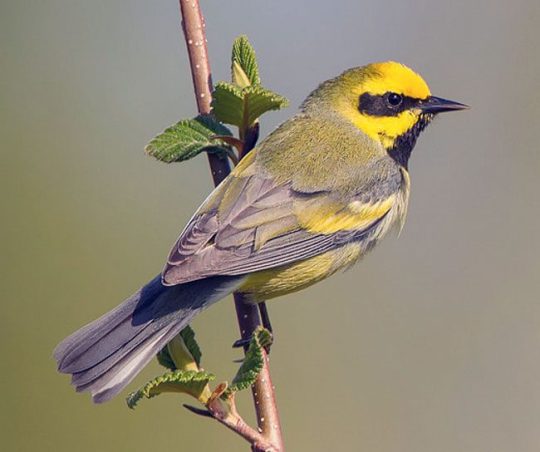
Lawrence's Warbler (Vermivora chrysoptera x cyanoptera) (F2 backcross), family Parulidae, order Passeriformes
photograph by Corey Hayes
In many ways, Golden-winged Warblers and Blue-winged Warblers appear to be completely distinct species—they look different, they sing different songs, and in recent history they have lived in different places, with golden-wings in the Northeast and upper Midwest and blue-wings in a band slightly farther south from the Ozarks to the Appalachian Mountains. Where the two species overlap, they produce hybrids—including the forms called Brewster’s and Lawrence’s warblers...
Read more: Golden-winged and Blue-winged Warblers Are 99.97 Percent Alike Genetically | Living Bird | All About Birds
189 notes
·
View notes
Photo

Blue-winged Warbler (Vermivora cyanoptera) - photo by Matthew Studebaker
175 notes
·
View notes
Photo

Blue-winged Warbler (Vermivora cyanoptera) #warbler #bluewingedwarbler #blue #yellowbird #felting #joeandsarahart
#warbler#blue#joeandsarahart#yellowbird#bluewingedwarbler#felting#crafts#birdwatching#artists on tumblr#birb#naturephotography#softsculpture#sculpture
7 notes
·
View notes
Photo

Blue-winged Warbler (Vermivora cyanoptera) -- Green-wood Cemetery
0 notes